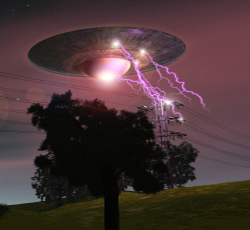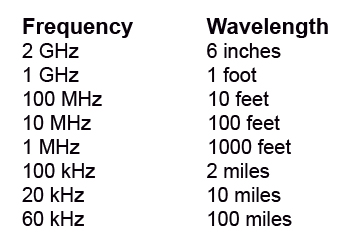Electromagnetic interference, often referred to as EMI, is a degradation of the performance of a piece of equipment or system caused by electromagnetic radiation.
Electromagnetic radiation is the travel of alternating electric and magnetic fields through space at 186,273 miles (about a billion feet) per second, or the speed of light.
A wavelength, as shown in Figure 1 below, is the physical distance traveled by a wave during one cycle. When the equipment or system is closer than about a sixth of a wavelength from the radiation source, it’s said to be in the nearfield of the source.
Most audio systems are in the nearfield at all frequencies below about 1 MHz, including 60 Hz (hum) and its harmonics (buzz). In the nearfleld, either the magnetic or electric field dominates, and each requires a different kind of treatment to eliminate interference.
For example, twisting of signal pairs reduces pickup of magnetic fields while shielding reduces pickup of electric fields. (We’ve discussed these topics in previous articles here).
However, when radiation sources have frequencies above about 1 MHz, the magnetic and electric fields travel together and are collectively called a wave. Most audio systems are in the far-field of the radiation source at these “radio” frequencies, hence the older term RFI for radio-frequency interference.
Generally, the newer term EMI also refers exclusively to radio-frequency interference. RF interference may originate in either intentional or unintentional radiators. Familiar intentional radiators include broadcast stations, amateur transmitters, and cell phones.
Unintentional radiators include devices such as electric welders, brush-type motors, relays, and switches that produce arcs, which are potent sources of brief bursts of wide-band interference. Less obvious sources include arcing or corona discharge on power line insulators (common in coastal or high-humidity areas) or malfunctioning fluorescent or neon lighting. Of course, lightning (the ultimate spark) is a well-known producer of momentary RF interference to virtually anything electronic.
About Antennas
An antenna converts an electrical signal into electromagnetic radiation and vice-versa. In other words, a good receiving antenna is also a good transmitting antenna. Most intentional transmitters and receivers use highly efficient antennas carefully “tuned” for the purpose.
But, depending on frequency, almost any conductor can become an antenna—even if we call it an audio cable, an RS-232 cable, or a printed-circuit board! [1] RF interference is most often picked up by signal cables, which then deliver the induced voltage to the audio equipment.
A cable, or circuit board trace, becomes a particularly efficient antenna when its physical length is a half, quarter, or eighth of a wavelength at the interference frequency. Therefore, any cable longer than about 75 feet O/S wavelength at 1,600 kHz) can inadvertently become an AM radio antenna and a cable only a few feet long can become an efficient VHF/FM antenna because of the shorter wavelengths.

















